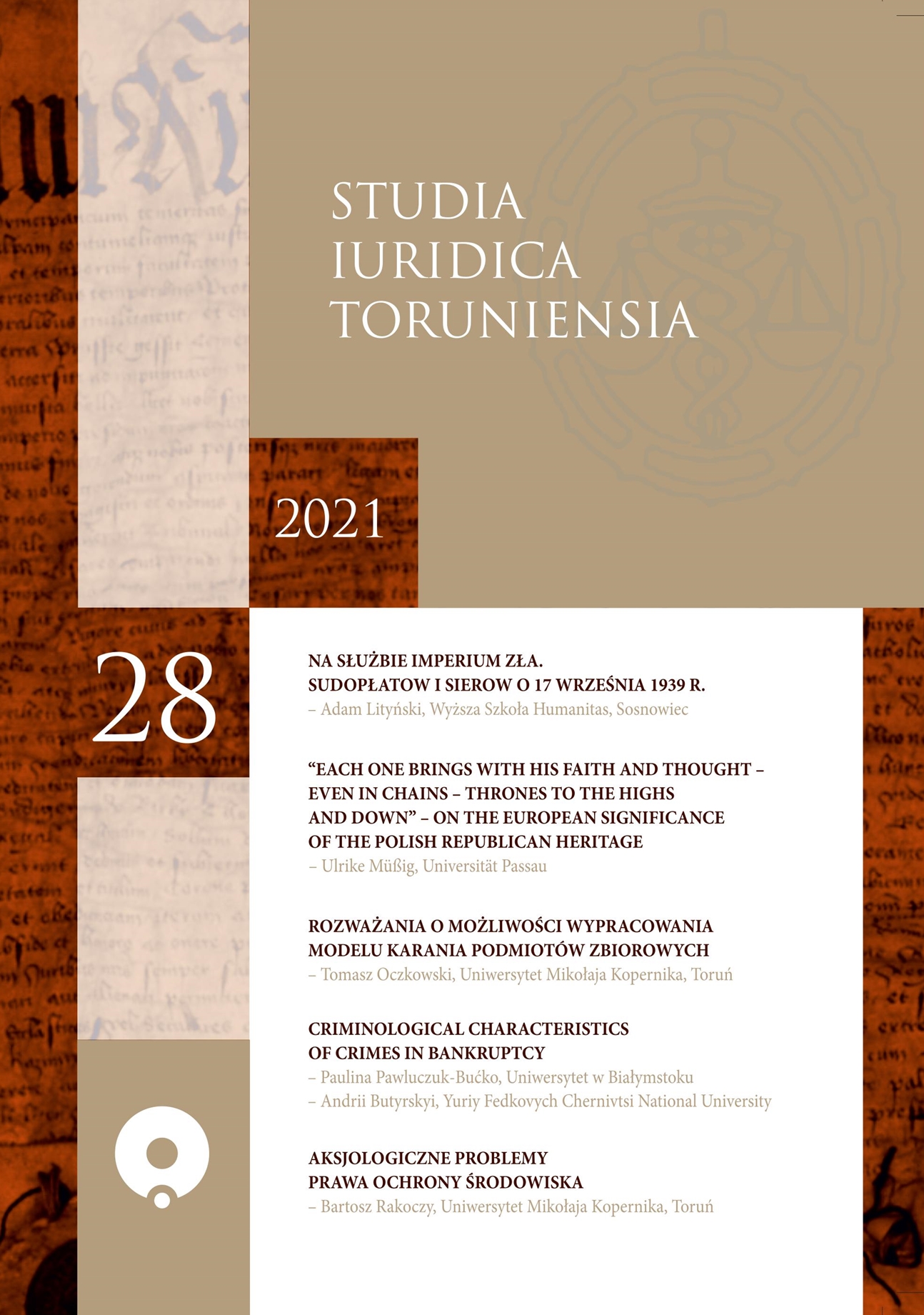Criminological characteristics of crimes in bankruptcy
DOI:
https://doi.org/10.12775/SIT.2021.012Keywords
bankruptcy, crime, criminology, debtor, creditorAbstract
The article is devoted to investigating the problems of the causes of crimes in bankruptcy proceedings. The purpose of the article is to identify and analyze the causes of bankruptcy crimes achieved through the establishment of: types of bankruptcy crimes, subjects of bankruptcy crimes, motives for committing bankruptcy crimes, peculiarities of crimes at different stages of bankruptcy. The theoretical basis of the study was the scientific work of scientists and practitioners in the field of criminology, criminal law and economic law. The authors have developed their own concept, which is based on the so-called bankruptcy rhombus, which defines the composition and location of each of the participants in the bankruptcy case, is ideally suited to identify the subjects and object of the bankruptcy crime, because it allows you to see the degree of interest of participants in the case bankruptcy and their hierarchy. Now let’s look at the causes of the crime each participant individually, starting from the bottom of the rhombus – from the debtor. To achieve this goal and to solve it set of tasks during the study was used a set of various methods of cognition, among which can be distinguished: dialectical, systemic analysis, formal-logical, systemic-structural.
References
Belohlavek A.J., Ordre Public and Cross-Border Insolvency: Especially in Relation to Council Regulation (EC), No. 1346/2000 on Insolvency Proceedings (March 27, 2015). Conference work paper, Joint conference of the WJA – World Jurist Association, Washington D.C. & WSM University Warsaw, Poland 2015.
Bińkowska M., Niemirska-Fido K., Walawender R.A., The bankruptcy and reorganisation law: bilingual edition, Warsaw 2010.
Box M., Gratzer K., Lin X., The Asymmetric Effect of Bankruptcy Fraud in Sweden: A Long-Term Perspective, “Journal of Quantitative Criminology” 2019, No. 35, https://doi.org/10.1007/s10940-018-9380-2, https://www.researchgate.net/publication/324687396.
Brown J.B., Netoles B., Taliani Rasnak S., Tighe M., Identifying Bankruptcy Fraud, United States of America: Credit Research Foundation
Butyrska I., Правовий статус учасників справи про банкрутство [Pravovyj status uchasnykiv spravy pro bankrutstvo], Chernivci 2017.
Butyrskyi A., Концепція удосконалення законодавства про неспромож-ність [Koncepcija udoskonalennja zakonodavstva pro nespromožnist’], „Pravo Ukrainy” 2018, No. 6.
Górniok O., Przestępczość gospodarcza i jej zwalczanie, Warsaw 1994.
Guzik-Makaruk E.M., Regulacje pozakodeksowe jako instrument zwalczania przestępczości zorganizowanej, in: Przestępczość zorganizowania, ed. E.W. Pływaczewski, Warsaw 2011.
Kozlovskyi N., Butyrskyi S., Poliakov A., Bobkova B., Lavrov A., Ivanyuta R., Management and comprehensive assessment of the probability of bankruptcy of Ukrainian enterprises based on the methods of fuzzy sets theory, “Problems and Perspectives in Management” 2019, No. 17 (3).
Kraciuk J., Przestępstwa gospodarcze w przedsiębiorstwach i sposoby ich przeciwdziałania, „Zeszyty Naukowe Uniwersytetu Szczecińskiego” 2012, No. 690.
Pływaczewski E.W. (ed.), Current problems of the penal law and criminology: Aktuelle Probleme des Strafrechts und der Kriminology, Warszawa 2012.
Poliakov B., Правонарушения в сфере банкротства в Украине [Pravonarusheniya v sfere bankrotstva v Ukraine], “Sanacija ta bankrutstvo” 2016, No. 1–2.
Downloads
Published
How to Cite
Issue
Section
License

This work is licensed under a Creative Commons Attribution-NoDerivatives 4.0 International License.
Stats
Number of views and downloads: 1039
Number of citations: 0



